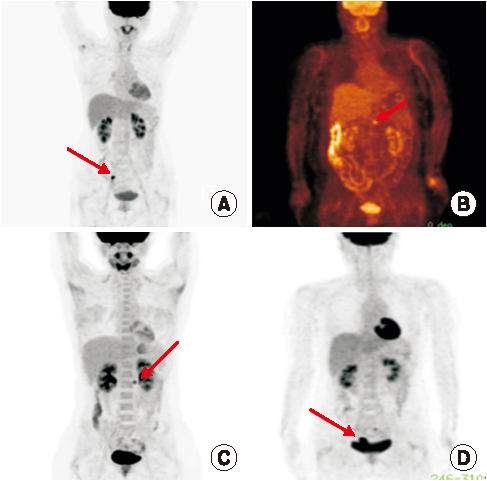Ewha Med J.
2019 Apr;42(2):15-19. 10.12771/emj.2019.42.2.15.
Is Second Look Laparoscopy for Diagnosing Remaining Ovarian Cancer Appropriate Further Treatment?
- Affiliations
-
- 1Department of Obstetrics and Gynecology, Ewha Women Cancer Center, Ewha Womans University College of Medicine, Seoul, Korea. mhsmhs@ewha.ac.kr
- KMID: 2444726
- DOI: http://doi.org/10.12771/emj.2019.42.2.15
Abstract
OBJECTIVES
The aim of our study is to compare the findings of investigative modalities and second look laparoscopy in ovarian cancer and establish the safety and accuracy of second look laparoscopy for detecting ovarian cancer.
METHODS
We retrospectively reviewed 11 patients with ovarian cancer treated by a single surgeon from 2006 to 2013. These patients were diagnosed at the time of primary cytoreductive surgery and received six cycles of combination chemotherapy. Then, they underwent second look laparoscopy. They were followed up with tumor markers monthly and PET-CT and/or CT scans.
RESULTS
All 11 patients had undergone primary surgery followed by six cycles of consolidation chemotherapy. Eight patients had positive pathologic findings on second look laparoscopy (72.7 %). The CA 125 level was higher in one patient (12.5%). In seven patients who had positive results on second look laparoscopy, the value was well below normal limits (87.5%). Three patients had recorded increases in fluorodeoxyglucose uptake (37.5%). The increase in standardized uptake values in specific regions in the scans corresponded to positive biopsies from those regions. Seven patients who had positive findings on second look laparoscopy were treated with consolidation chemotherapy. The 5-year survival rate was 66.67%, and the 5-year recurrence rate was 33.33%.
CONCLUSION
There are limitations to the accuracy of current investigative techniques, and we must rely on clinical correlation with these modalities for each case of second look laparoscopy. It is feasible to safely perform second look laparoscopy to detect remnant ovarian cancer.
Keyword
MeSH Terms
Figure
Reference
-
1. Ferlay J, Shin HR, Bray F, Forman D, Mathers C, Parkin DM. Estimates of worldwide burden of cancer in 2008: GLOBOCAN 2008. Int J Cancer. 2010; 127:2893–2917.
Article2. Jung KW, Won YJ, Kong HJ, Oh CM, Cho H, Lee DH, et al. Cancer statistics in Korea: incidence, mortality, survival, and prevalence in 2012. Cancer Res Treat. 2015; 47:127–141.
Article3. Park B, Park S, Kim TJ, Ma SH, Kim BG, Kim YM, et al. Epidemiological characteristics of ovarian cancer in Korea. J Gynecol Oncol. 2010; 21:241–247.
Article4. Zeng LJ, Xiang CL, Gong YZ, Kuang Y, Lu FF, Yi SY, et al. Neoadjuvant chemotherapy for patients with advanced epithelial ovarian cancer: a meta-analysis. Sci Rep. 2016; 6:35914.
Article5. Podratz KC, Kinney WK. Second-look operation in ovarian cancer. Cancer. 1993; 71:1551–1558.6. Wangensteen OH, Lewis FJ, Tongen LA. The “second-look” in cancer surgery: a patient with colic cancer and involved lymph nodes negative on the “sixth-look”. J Lancet. 1951; 71:303–307.7. Hauth EA, Antoch G, Stattaus J, Kuehl H, Veit P, Bockisch A, et al. Evaluation of integrated whole-body PET/CT in the detection of recurrent ovarian cancer. Eur J Radiol. 2005; 56:263–268.
Article8. Husain A, Chi DS, Prasad M, Abu-Rustum N, Barakat RR, Brown CL, et al. The role of laparoscopy in second-look evaluations for ovarian cancer. Gynecol Oncol. 2001; 80:44–47.
Article9. US Cancer Statistics Working Group. United States cancer statistics: 1999–2014 incidence and mortality web-based report [Internet]. Atlanta (GA): Department of Health and Human Services;Centers for Disease Control and Prevention;National Cancer Institute;c2017. cited 2019 Feb 2. Available from: http://www.cdc.gov/uscs.10. Friedman JB, Weiss NS. Second thoughts about secondlook laparotomy in advanced ovarian cancer. N Engl J Med. 1990; 322:1079–1082.
Article11. Nezhat FR, Pejovic T, Finger TN, Khalil SS. Role of minimally invasive surgery in ovarian cancer. J Minim Invasive Gynecol. 2013; 20:754–765.
Article12. Schwartz PE, Smith JP. Second-look operations in ovarian cancer. Am J Obstet Gynecol. 1980; 138:1124–1130.
Article13. Dogan NU, Schneider A, Chiantera V, Dogan S, Dursun P. Tertiary cytoreduction in the setting of recurrent ovarian cancer (review). Oncol Lett. 2013; 6:642–647.
Article14. Rubin SC, Hoskins WJ, Saigo PE, Chapman D, Hakes TB, Markman M, et al. Prognostic factors for recurrence following negative second-look laparotomy in ovarian cancer patients treated with platinum-based chemotherapy. Gynecol Oncol. 1991; 42:137–141.
Article15. Oksefjell H, Sandstad B, Trope C. The role of secondary cytoreduction in the management of the first relapse in epithelial ovarian cancer. Ann Oncol. 2009; 20:286–293.
Article
- Full Text Links
- Actions
-
Cited
- CITED
-
- Close
- Share
- Similar articles
-
- Two cases of peritoneal tuberculosis mimicking ovarian carcinoma diagnosed with laparoscopy
- Laparoscopic Conservative Surgery of One Case of Ovarian Pregnancy
- A Case of Laparoscopic Conservative Surgery for Ovarian Pregnany
- Diagnostic Laparoscopy of Patient with Deep Vein Thrombosis before Diagnosis of Ovarian Cancer: A Case Report
- Early port-site metastasis during neoadjuvant chemotherapy in advanced stage ovarian cancer: report of two cases


